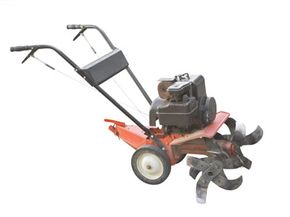Lawn Tiller Basics
Tillers are pretty simple machines. The central component of any lawn tiller is the tines -- the rotating metal blades that dig into the soil. The tines are sharp on the edge, but that isn't the secret to tilling magic. It's the shape of the tines that can take the credit. Each tine consists of four blades curved in opposing directions. Blades one and three are curved pointing in toward the tiller; blades two and four point away from the tiller. The inverted tines keep material from accumulating on the blades. The outward pointing tines are the heavy cutters. They all work in conjunction with each other to dig into the soil aggressively, while moving it away from the blades to avoid clogging. The tines are grouped in twos and there are generally two to four sets on most home-consumer tillers. The gardener steers the tiller by holding on to two long handle bars that point toward him or her.
Horsepower refers to the size of the engine that turns the tines, and in some cases, the wheels. The more of it you have, the easier it is to dig deeper into the soil. Smaller four-tined tillers generally have one to five horsepower engines. Larger models with eight tines come with engines that have the power of five to 12 horses. Aside from large and small, the other distinguishing factor in tiller land is whether the tines are in front of the wheels or behind them.
Advertisement
This is also what makes a tiller self-propelled or not. If it's a front-tined machine, the wheels are in the rear and only used to guide the tiller along. The actual forward propulsion comes from the tines digging into the soil and pulling the unit forward. Rear-tined tillers have wheels in the front that are mounted on a turning axel like a car. In this case, the wheels pull the unit forward when put in gear and the tines' only job is to dig. Most times, the rear-tines spin in the opposite direction of travel to provide more friction, which results in deeper digging. These are called counter-rotating tines. You can also go with one that has standard rotating tines, meaning the blades spin in a forward direction.
On front-tined tillers, the gardener pushes down on the handles, which raises the spinning tines, to get the tiller from one place to another. When it's in the right place, the front end is lowered and the tines dig in, pulling the machine forward. Rear-tined tillers have tines that only spin when you want them to. The wheels turn and pull the machine forward until you get to the right spot. Then with the simple pull of a lever, the tines begin spinning. While it's unsafe and nearly impossible to pull a front-tined tiller backwards, rear-tined models come with a reverse gear, and since the tines are already spinning in that direction, it's not too hard to back it up.
The tines on all tillers can be adjusted for depth, depending on how far down you need to go. The width of the path is determined by how many tines are at work. Smaller mini-cultivators only dig an 8-inch (20-centimeter) wide swath. Full-sized consumer tillers with eight tines can dig as wide as 3 feet (0.9 meters) in a single pass. There are also wider 12- to 16-tined tillers that hook onto the back of a tractor and connect to the transmission to spin the tines. These are mainly for commercial agricultural use and home farmers.
Plow ahead to find out how to choose your tiller.
